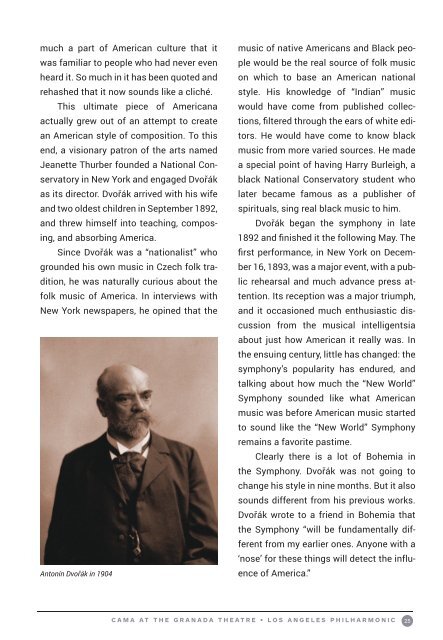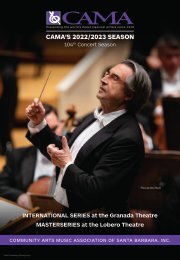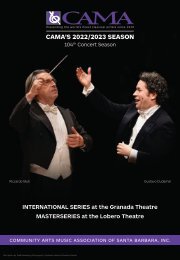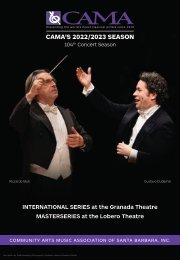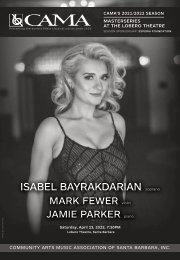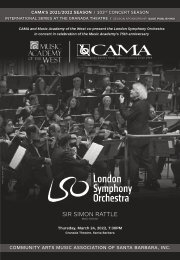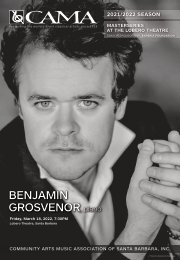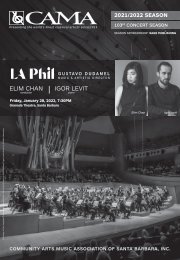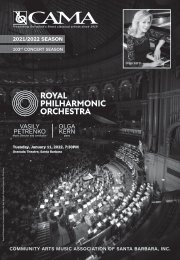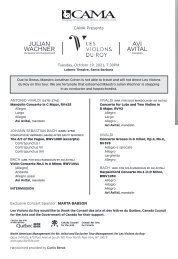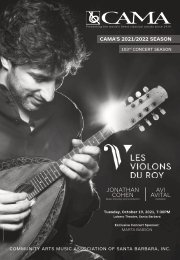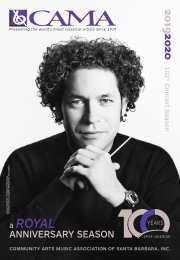CAMA + LA Phil / Gala 100th Anniversary Concert / 100 Years to the Day / March 6, 1920 – March 6, 2020 / International Series at The Granada Theatre
On Friday, March 6, 2020, LA Phil will play a special 100th Anniversary Concert at The Granada Theatre in Santa Barbara as part of CAMA's 101st Season. Maestro Gustavo Dudamel will direct a program of Charles Ives and Antonin Dvorak's New World Symphony. This concert marks 100 years to the day from LA Phil's first concert in Santa Barbara on March 6, 1920. CAMA and LA Phil join in celebrating this remarkable "Centennial moment!" — Photo of Gustavo Dudamel ©Citizens of Humanity, courtesy of the Los Angeles Philharmonic Association. ★—CONCERT AND SPECIAL EVENTS: Friday, March 6, 2020—★ 5:00PM doors/5:15PM start—LECTURE by Hattie Beresford at The New Vic Theater—Open to All Reservations recommended—email tickets@camasb.org 6:00PM—RED-CARPET RECEPTION at The Granada Theatre All ticket holders invited—no reservation needed 7:00PM—CONCERT (The Granada Theatre) / No Late Seating / Concert ends approx.9:00PM More information: https://camasb.org/international-series-2019-2020/#2020-03-06 #CAMASB #CAMA101 #CAMACentennial #LAPhil100 #CAMAat100
On Friday, March 6, 2020, LA Phil will play a special 100th Anniversary Concert at The Granada Theatre in Santa Barbara as part of CAMA's 101st Season. Maestro Gustavo Dudamel will direct a program of Charles Ives and Antonin Dvorak's New World Symphony. This concert marks 100 years to the day from LA Phil's first concert in Santa Barbara on March 6, 1920. CAMA and LA Phil join in celebrating this remarkable "Centennial moment!" — Photo of Gustavo Dudamel ©Citizens of Humanity, courtesy of the Los Angeles Philharmonic Association.
★—CONCERT AND SPECIAL EVENTS: Friday, March 6, 2020—★
5:00PM doors/5:15PM start—LECTURE by Hattie Beresford at The New Vic Theater—Open to All
Reservations recommended—email tickets@camasb.org
6:00PM—RED-CARPET RECEPTION at The Granada Theatre
All ticket holders invited—no reservation needed
7:00PM—CONCERT (The Granada Theatre) / No Late Seating / Concert ends approx.9:00PM
More information: https://camasb.org/international-series-2019-2020/#2020-03-06
#CAMASB #CAMA101 #CAMACentennial #LAPhil100 #CAMAat100
You also want an ePaper? Increase the reach of your titles
YUMPU automatically turns print PDFs into web optimized ePapers that Google loves.
much a part of American culture th<strong>at</strong> it<br />
was familiar <strong>to</strong> people who had never even<br />
heard it. So much in it has been quoted and<br />
rehashed th<strong>at</strong> it now sounds like a cliché.<br />
This ultim<strong>at</strong>e piece of Americana<br />
actually grew out of an <strong>at</strong>tempt <strong>to</strong> cre<strong>at</strong>e<br />
an American style of composition. To this<br />
end, a visionary p<strong>at</strong>ron of <strong>the</strong> arts named<br />
Jeanette Thurber founded a N<strong>at</strong>ional Conserva<strong>to</strong>ry<br />
in New York and engaged Dvořák<br />
as its direc<strong>to</strong>r. Dvořák arrived with his wife<br />
and two oldest children in September 1892,<br />
and threw himself in<strong>to</strong> teaching, composing,<br />
and absorbing America.<br />
Since Dvořák was a “n<strong>at</strong>ionalist” who<br />
grounded his own music in Czech folk tradition,<br />
he was n<strong>at</strong>urally curious about <strong>the</strong><br />
folk music of America. In interviews with<br />
New York newspapers, he opined th<strong>at</strong> <strong>the</strong><br />
An<strong>to</strong>nín Dvořák in 1904<br />
music of n<strong>at</strong>ive Americans and Black people<br />
would be <strong>the</strong> real source of folk music<br />
on which <strong>to</strong> base an American n<strong>at</strong>ional<br />
style. His knowledge of “Indian” music<br />
would have come from published collections,<br />
filtered through <strong>the</strong> ears of white edi<strong>to</strong>rs.<br />
He would have come <strong>to</strong> know black<br />
music from more varied sources. He made<br />
a special point of having Harry Burleigh, a<br />
black N<strong>at</strong>ional Conserva<strong>to</strong>ry student who<br />
l<strong>at</strong>er became famous as a publisher of<br />
spirituals, sing real black music <strong>to</strong> him.<br />
Dvořák began <strong>the</strong> symphony in l<strong>at</strong>e<br />
1892 and finished it <strong>the</strong> following May. <strong>The</strong><br />
first performance, in New York on December<br />
16, 1893, was a major event, with a public<br />
rehearsal and much advance press <strong>at</strong>tention.<br />
Its reception was a major triumph,<br />
and it occasioned much enthusiastic discussion<br />
from <strong>the</strong> musical intelligentsia<br />
about just how American it really was. In<br />
<strong>the</strong> ensuing century, little has changed: <strong>the</strong><br />
symphony’s popularity has endured, and<br />
talking about how much <strong>the</strong> “New World”<br />
Symphony sounded like wh<strong>at</strong> American<br />
music was before American music started<br />
<strong>to</strong> sound like <strong>the</strong> “New World” Symphony<br />
remains a favorite pastime.<br />
Clearly <strong>the</strong>re is a lot of Bohemia in<br />
<strong>the</strong> Symphony. Dvořák was not going <strong>to</strong><br />
change his style in nine months. But it also<br />
sounds different from his previous works.<br />
Dvořák wrote <strong>to</strong> a friend in Bohemia th<strong>at</strong><br />
<strong>the</strong> Symphony “will be fundamentally different<br />
from my earlier ones. Anyone with a<br />
‘nose’ for <strong>the</strong>se things will detect <strong>the</strong> influence<br />
of America.”<br />
<strong>CAMA</strong> AT THE GRANADA THEATRE • LOS ANGELES PHILHARMONIC<br />
25


